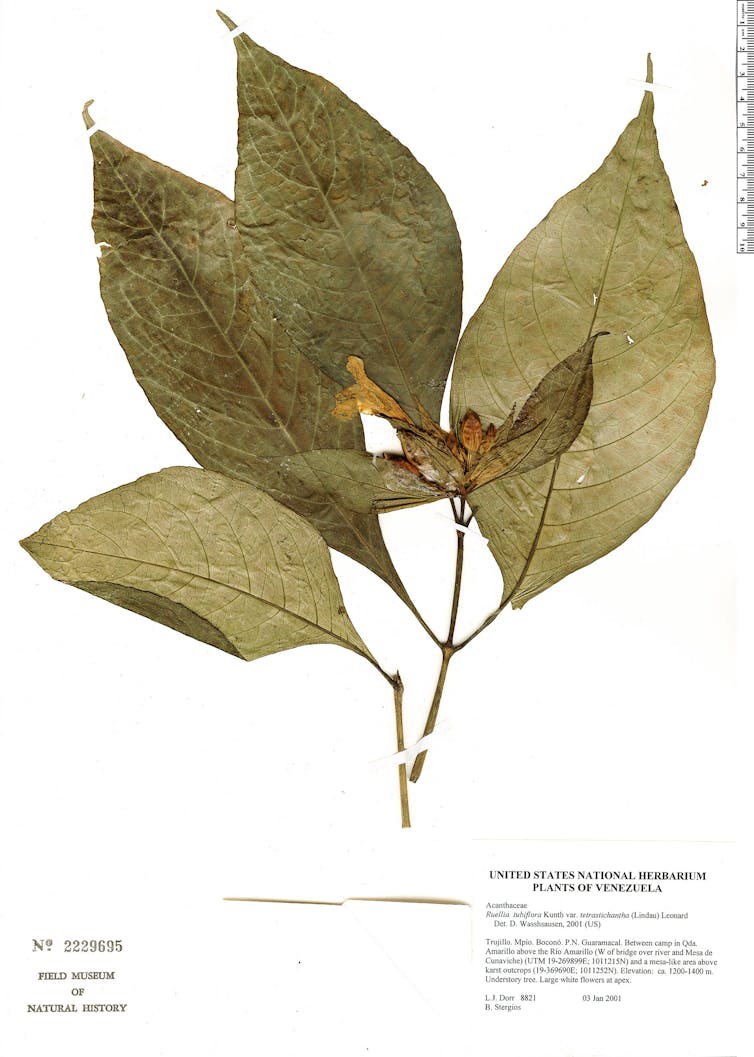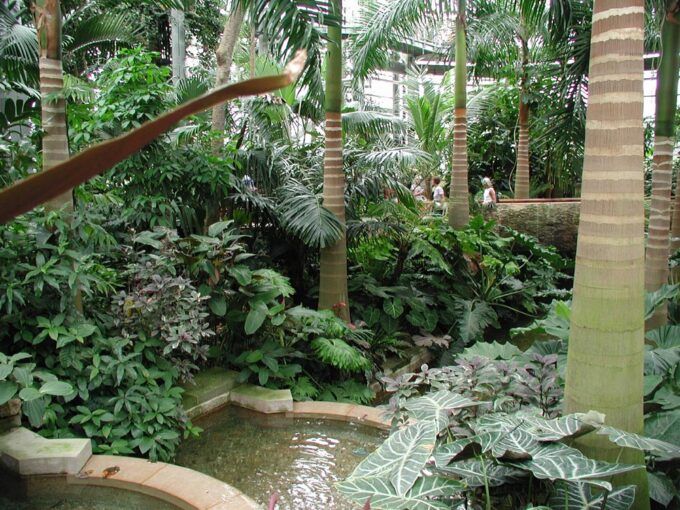Some of the world’s most popular museums are natural history collections: Think of dinosaur fossils, gemstones and preserved animals. Herbaria – collections of pressed, dried plant specimens – are a less-known but important type of natural history collection. There are some 400 million botanical specimens stored across over 3,500 herbaria around the world, but most are not widely publicized and rarely host public exhibits.
I study biodiversity and global change, and these collections have fueled my work. My collaborators and I have used herbarium collections to study how flowering times respond to changes in climate, how dispersal traits and environmental preferences affect the likelihood that plants will become invasive, and how fires affect tropical biodiversity.
I have had easy access to specimens from every corner of the world, but most researchers are not as lucky. This is partly because herbaria as we know them today are largely a European creation. And like other natural history collections, many of them grew as imperial powers expanded their colonial empires and amassed all kinds of resources from their colonies. Today, over 60% of herbaria and 70% of specimens are located in developed countries with colonial histories.
My colleagues and I wanted to understand how many herbarium specimens are not where the plants originated and are housed in former colonizing countries instead. Our international team of researchers from herbaria on every continent analyzed over 85 million plant specimen records from the Global Biodiversity Information Facility, the largest online repository of biodiversity data, and also surveyed physical herbarium collections across the world.
We found that many former colonial powers have more plant diversity in their herbarium cabinets than they do in nature. Our data suggest that this is not the case, however, for former colonies, whose herbaria often house fewer plant species in their collections than are found naturally in the region. This disparity can limit former colonies’ capacity for botanical research.
A persistent colonial legacy
Herbaria are centers of botanical discovery and research, and are critical for understanding the diversity of plants and fungi around the world. The specimens they hold were originally collected to document and classify species. Today scientists use them for additional purposes, such as reconstructing plant evolutionary history, tracking pollution trends and identifying potential new drugs.
Botany was the science par excellence of colonial empires. Botanists moved numerous living and preserved plant specimens to institutions in colonizing nations which sought to exploit their colonies’ biological resources.
For instance, physician and naturalist Hans Sloane, often credited as the inventor of chocolate milk, acquired numerous plant specimens from overseas colonies via his connections with the slave trade. His collections formed the basis of Britain’s Natural History Museum. Well-known scientists, including Charles Darwin and Carl Linnaeus and their disciples, relocated large numbers of plants from across the globe to European museums and collections.
Our analyses of online specimen records suggest that botanical collection trends over the past four centuries have been shaped by colonialism. Even though overt colonialism ended after World War II, specimens have largely continued to move from Africa, Asia and South America to institutions in Europe and North America, with a few exceptions.
Similarly, when we examined physical herbarium collections, we found that those in developed nations in the Global North that were former colonizers housed a higher proportion of internationally collected specimens on average. Herbaria in the U.S. and several European nations house specimens of over twice the number of species that naturally occur in these nations.
In nature, plant diversity is typically greatest in regions near the equator and decreases northward and southward toward the poles. Our data suggest that centuries of colonialism had the opposite effect: Plant specimens were moved away from countries with high natural plant diversity to collections in countries where fewer plant species occur naturally.

Field Museum, CC BY-ND
The digital divide
As herbaria digitize their specimens and share data online, they are becoming somewhat more decentralized and democratic. Open-access data repositories, such as the Global Biodiversity Information Facility, allow researchers from around the world to query aggregated specimen metadata and images over the internet. This reduces the need to ship fragile specimens over long distances, and to take extensive and costly research trips.
But digitization requires large investments in equipment and personnel, which small institutions and developing countries often can’t afford. Stable internet connections are not always widely available in developing countries either. Further, our survey of herbaria indicates that digitization still has a long way to go.
We estimated that in general, fewer than 30% of physical collections have information online that at least describes when and where specimens were collected, and fewer than 10% have digital images available online. Most herbaria that responded to our inquiries were located in developed countries, so these figures probably overestimate the state of specimen digitization. The disparity in access to herbarium collections exists in the digital realm as well.
Making global plant collections more inclusive
Many natural history museums and other cultural institutions are working now to address their colonial legacies. This often includes acknowledging items in their collections that were acquired unethically or illegally, and sometimes returning them to their original sources. But botanical collections have received less attention, maybe because few of them offer public displays.
Our study shows that there is a large disparity between where plant diversity naturally exists and where it is artificially housed and cataloged. As a result, many countries rely on botanical knowledge and resources housed outside of their own borders.
My colleagues and I believe that herbaria should be part of the ongoing movement to decolonize cultural institutions, natural history museums and related scientific practices. Key steps would include:
– Openly acknowledging the colonial legacy of herbarium collections, and communicating their history;
– Improving access to the vast information held in herbaria worldwide; and
– Building capacity in previously colonized countries by sharing knowledge and resources for contributing to research. These could include, for instance, supporting the local collection and study of plant diversity by providing training for local scientists.
In our view, the science that comes from botanical collections is globally relevant, so access to these resources should be within reach of the global community. Herbarium collections are critical to modern understanding of the world’s plants, and they have played key roles in numerous scientific discoveries and advances. Imagine how much more would be possible if these invaluable resources were available to all.

No comments:
Post a Comment